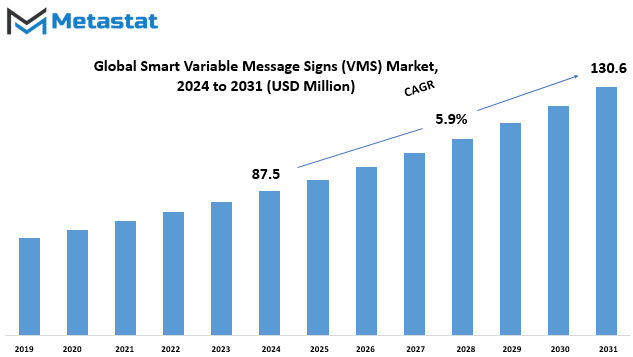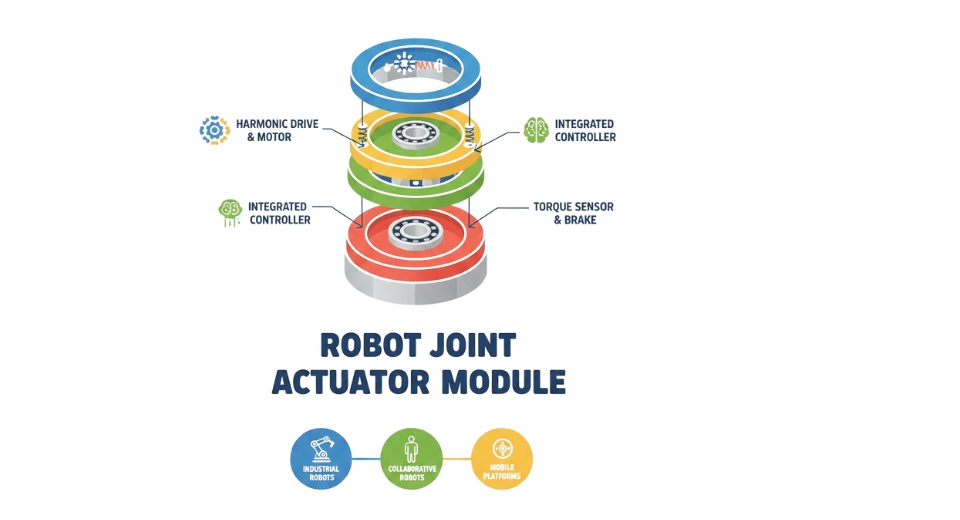MARKET OVERVIEW
The Global Smart Variable Message Signs (VMS) Market is a dynamic sector that plays a pivotal role in modern transportation systems. These signs, equipped with intelligent technology, have revolutionized the way information is conveyed to motorists and pedestrians on roads and highways. Smart VMS go beyond traditional static signage, providing real-time updates and dynamic information to enhance traffic management, safety, and overall efficiency in urban mobility.
Smart VMS are digital displays strategically placed along roadways, highways, and urban centers. Unlike their static counterparts, these signs are embedded with cutting-edge technology, enabling them to adapt and communicate dynamically based on the prevailing traffic conditions, emergencies, or specific events. The integration of smart technologies, such as sensors and connectivity, empowers these signs to deliver pertinent information promptly and responsively.
One of the key drivers of the Global Smart VMS market is the growing emphasis on intelligent transportation systems (ITS) to mitigate traffic congestion and enhance road safety. As urban populations continue to swell, the demand for efficient traffic management solutions becomes increasingly pressing. Smart VMS address this challenge by offering real-time traffic updates, alternative route suggestions, and crucial information, thereby contributing to smoother traffic flow and reduced congestion.
Furthermore, the rise of smart cities across the globe has propelled the adoption of Smart VMS as an integral component of modern urban infrastructure. These signs play a vital role in creating connected and responsive urban environments, where data-driven decisions contribute to a more streamlined and sustainable urban mobility experience. Governments and city planners are recognizing the potential of Smart VMS in optimizing traffic patterns, reducing emissions, and improving the overall quality of life for urban dwellers.
The Global Smart VMS market is characterized by a diverse range of applications. Beyond traffic management, these signs find utility in disseminating critical information during emergencies, construction zones, and public events. The adaptability of Smart VMS to convey variable messages in real-time ensures that they remain invaluable tools for authorities to communicate swiftly and effectively with the public.
As technology continues to advance, the Global Smart VMS market is poised for further growth and innovation. The integration of artificial intelligence, machine learning, and advanced analytics into these systems holds the potential to elevate their capabilities, making them even more responsive and predictive in addressing the challenges of urban mobility. The ongoing evolution of Smart VMS reflects a commitment to creating smarter, safer, and more efficient transportation networks globally.
The Global Smart Variable Message Signs (VMS) market is a vibrant and transformative segment within the broader realm of intelligent transportation systems. Its significance extends beyond conventional static signage, offering real-time adaptability and responsiveness that contribute to enhanced traffic management, safety, and overall urban mobility. As the world continues to embrace smart technologies, Smart VMS stands at the forefront, shaping the future of transportation and communication on our roads and in our cities.
Global Smart Variable Message Signs (VMS) market is estimated to reach $130.6 Million by 2031; growing at a CAGR of 5.9% from 2024 to 2031.

GROWTH FACTORS
The Global Smart Variable Message Signs (VMS) market experiences growth propelled by various factors. One prominent driver is the increasing emphasis on road safety and traffic management, fostering the adoption of intelligent transportation systems that incorporate VMS. These signs play a pivotal role in conveying real-time information to drivers, contributing to safer and more efficient traffic flow.
Advancements in communication technologies and data analytics further bolster the market. These developments facilitate seamless integration of VMS with traffic management systems and align with smart city initiatives. The result is a more interconnected and responsive traffic infrastructure, enhancing overall urban mobility.
However, the market faces challenges, particularly in regions with budget constraints. The high upfront investment and infrastructure costs associated with implementing Smart VMS can limit adoption. In such areas, the potential benefits may be overshadowed by financial considerations, hindering the widespread deployment of these intelligent signage systems.
Additionally, regulatory challenges pose a hurdle to market growth. Compliance with specific guidelines regarding VMS message content, placement, and control is imperative. Navigating these regulations requires careful attention to detail to ensure that the implementation of Smart VMS aligns with established standards, avoiding potential setbacks in deployment.
Despite these challenges, the market holds promising opportunities. The integration of Smart VMS with connected vehicles and autonomous driving systems emerges as a lucrative prospect. This integration not only enables enhanced traffic management but also facilitates dynamic control and improved communication with drivers. As the automotive industry continues to embrace connectivity and autonomy, synergy with Smart VMS presents avenues for substantial growth in the coming years.
The Global Smart Variable Message Signs market is influenced by a combination of drivers and challenges. While the emphasis on road safety and advancements in communication technologies fuel growth, upfront costs and regulatory considerations act as limiting factors. The integration of Smart VMS with emerging technologies, however, opens exciting possibilities for the market's future development.
MARKET SEGMENTATION
By Type
The Global Smart Variable Message Signs (VMS) market can be broken down into different types, with each type catering to specific needs within the market. One of these types is the Fixed Type, which amassed a value of 58.3 USD Million in the year 2022. This segment is characterized by signs that are stationary and don't move around. They serve a crucial role in conveying messages to the intended audience in a particular location.
On the other hand, we have the Mobile Type segment, valued at 20 USD Million in the same year. In contrast to the Fixed Type, Mobile Type VMS involves signs that are portable and can be moved to different locations as needed. This type of variable message sign is particularly useful in situations where dynamic communication is essential, and the message needs to reach different audiences at various locations.
The Fixed Type and Mobile Type segments represent two distinct approaches to the deployment of smart variable message signs, each offering its own set of advantages based on specific requirements. The Fixed Type provides stability and permanence, making it suitable for locations where a consistent message is needed over an extended period. On the flip side, the Mobile Type brings flexibility to the table, enabling the deployment of messages in diverse settings or emergency situations where a rapid response is necessary.
The Global Smart Variable Message Signs market, categorized by type, showcases a diverse range of applications. The Fixed Type and Mobile Type segments, with their respective values of 58.3 USD Million and 20 USD Million in 2022, highlight the varied needs within the market and the adaptability of smart variable message signs to meet those needs. As technology continues to advance, these types of signs play a vital role in effective communication strategies across different scenarios.
By Application
The Global Smart Variable Message Signs (VMS) market exhibits a diverse landscape, catering to various applications. These applications are crucial in different settings and contribute significantly to the market's overall dynamics. As we delve into the specifics, the market can be dissected based on its applications.
The notable sector is the Highway segment, which stood at a valuation of 33.9 USD Million in 2022. Highways are integral components of transportation networks, connecting regions and facilitating the movement of people and goods. Smart VMS in this context play a pivotal role in disseminating real-time information to motorists, enhancing traffic management, and ensuring a smoother flow of vehicles.
Next in line is the Toll segment, valued at 13.5 USD Million in 2022. Tolls are essential for maintaining infrastructure and managing traffic congestion. Smart VMS at toll plazas aid in communicating toll rates, payment methods, and traffic conditions, contributing to a more efficient toll collection process.
The Tunnel segment is another facet of the market, with a 2022 valuation of 13.8 USD Million. Tunnels present unique challenges in terms of safety and traffic management. Smart VMS installed in tunnels offer crucial information on safety protocols, traffic conditions within the tunnel, and emergency procedures, ensuring a secure passage for commuters.
Urban Locations form a significant application category as well. In urban settings, where traffic density is high, Smart VMS contribute to effective traffic management, guiding drivers through optimal routes, providing information on parking availability, and disseminating real-time updates on road conditions. The role of Smart VMS in urban areas is instrumental in alleviating congestion and enhancing overall mobility.
The market caters to an array of other applications. These miscellaneous applications could range from industrial zones, commercial areas, to special event locations. The versatility of Smart VMS technology allows it to address specific needs across diverse environments, contributing to the overall adaptability and effectiveness of the system.
The Global Smart Variable Message Signs market, segmented by application, reflects the indispensability of this technology in diverse scenarios. From highways to tunnels, urban landscapes to miscellaneous applications, Smart VMS play a pivotal role in enhancing communication, ensuring safety, and optimizing traffic flow across a spectrum of settings. The market's continued growth and impact underscore the importance of Smart VMS in modern transportation and infrastructure management.
By Component
The Global Smart Variable Message Signs (VMS) market is segmented based on its components, which are broadly classified into Hardware Components and Software Components.
Starting with Hardware Components, these are the tangible elements of the Smart VMS. They include the physical parts of the system, such as display screens, sensors, and other electronic devices. These components form the backbone of the Smart VMS, providing the necessary infrastructure for the system to function effectively.
On the other hand, Software Components are the intangible elements that govern the functionality of the Smart VMS. These components consist of programs, algorithms, and codes that operate the system, enabling it to process information, display messages, and respond to various inputs. In essence, the Software Components bring intelligence to the Smart VMS, allowing it to adapt and perform diverse functions.
The division of the Global Smart Variable Message Signs market into Hardware and Software Components reflects the dual nature of the system. While the Hardware Components provide the physical framework, the Software Components empower the Smart VMS with the intelligence needed to convey messages dynamically.
This segmentation is crucial for businesses and consumers alike, as it helps in understanding the distinct aspects of the Smart VMS market. Companies involved in the production of Hardware Components focus on the manufacturing and design of the physical elements, while those dealing with Software Components are concerned with developing the software infrastructure that drives the Smart VMS functionality.
The division of the Global Smart Variable Message Signs market into Hardware and Software Components provides a clear and practical framework for comprehending the different facets of this dynamic industry. This classification aids stakeholders in navigating the market landscape, making informed decisions, and contributing to the continued advancement of Smart VMS technology.

By Customer
The worldwide market for Smart Variable Message Signs (VMS) is categorized into various customer segments. These segments play a pivotal role in shaping the demand and utilization of Smart VMS across different sectors. The major customer segments include Government Road Authorities, Public Transit Agencies, Emergency Service Providers, Commercial Entities, and Public Event Organizers.
Government Road Authorities stand as a significant customer segment within the global Smart VMS market. They utilize these signs to convey essential information to road users, ensuring smooth traffic flow and enhancing overall road safety. The deployment of Smart VMS by Government Road Authorities facilitates effective communication with drivers, helping them navigate through diverse road conditions and situations.
Public Transit Agencies represent another vital customer segment in the Smart VMS market. These agencies employ variable message signs to provide real-time updates to commuters, ensuring timely and accurate information about public transportation schedules, delays, and other relevant details. The integration of Smart VMS technology contributes to a more efficient and user-friendly public transit experience.
Emergency Service Providers constitute a critical customer segment, leveraging Smart VMS to communicate important information during emergencies. These signs assist in directing traffic away from incident areas, guiding emergency responders, and disseminating crucial updates to the public. The swift and accurate communication facilitated by Smart VMS is paramount in emergency situations.
Commercial Entities form a noteworthy customer segment, employing Smart VMS for advertising and promotional purposes. These dynamic signs enable businesses to display targeted messages and advertisements, reaching a broad audience and enhancing brand visibility. The adaptability of Smart VMS makes it a valuable tool for commercial entities seeking innovative ways to engage with their target market.
Public Event Organizers complete the spectrum of customer segments in the global Smart VMS market. These organizers utilize variable message signs to provide event-related information, including directions, parking details, and real-time updates to attendees. The integration of Smart VMS enhances the overall experience of participants, contributing to the success of public events.
The diverse customer segments within the global Smart Variable Message Signs market showcase the versatility and widespread applicability of this technology. From facilitating smooth traffic management to enhancing public transit experiences, guiding emergency responses, supporting commercial endeavors, and optimizing public events, Smart VMS plays a crucial role across various domains, meeting the specific communication needs of each customer segment.
REGIONAL ANALYSIS
The examination of the Global Smart Variable Message Signs (VMS) market reveals a noteworthy division based on geography, highlighting North America and Europe as key regions. In scrutinizing the market's regional landscape, it becomes evident that geographical factors play a pivotal role in shaping the dynamics of the Smart VMS sector.
North America emerges as a prominent player in this market segment. The region's robust technological infrastructure, coupled with a high level of digital adoption, contributes significantly to the flourishing Smart VMS market. The prevalence of advanced communication networks and a tech-savvy consumer base creates a conducive environment for the growth of these variable message signs.
Meanwhile, Europe showcases its own set of characteristics influencing the Smart VMS market. With a diverse landscape encompassing various countries, each with unique economic and technological profiles, the European region manifests distinct opportunities and challenges. The market's response in Europe is intricately tied to the interplay of these factors, shaping the adoption and integration of Smart VMS solutions.
Both North America and Europe, despite their divergent contexts, share a common thread in driving the global Smart VMS market forward. The significance of these regions extends beyond their individual markets, contributing collectively to the overall growth and development of Smart Variable Message Signs on a global scale.
The examination of the Global Smart Variable Message Signs (VMS) market through a regional lens underscores the pivotal role played by geographical factors in shaping market dynamics. The distinct characteristics of North America and Europe offer a nuanced understanding of how regional nuances influence the adoption and integration of Smart VMS solutions. As the market continues to evolve, recognizing and navigating these regional intricacies will be instrumental in fostering sustained growth and success in the Smart VMS sector.
COMPETITIVE PLAYERS
In the Smart Variable Message Signs (VMS) market, a constellation of significant players actively contributes to the industry's growth and innovation. Among the notable competitors shaping this domain are Daktronics, Inc., Kustom Signals, Inc., SWARCO AG, 3M Company, Aesys S.p.A., Ver-Mac Industries, Inc., Shanghai Sansi Electronic Engineering, Fixalia Electronic Solutions, DYSTEN Ltd., Sernis - Soluções Tecnológicas, Lda, Chainzone Technology (Foshan) Co., Ltd, Masstrans Technologiies Private Limited, Displays & Mobility Solutions, BARTCO UK LTD, and Telegra.
Daktronics, Inc. stands as a pivotal player in the Smart VMS sector, leveraging its expertise to offer innovative solutions. Kustom Signals, Inc. also plays a significant role, contributing to the competitive landscape with its specialized offerings. SWARCO AG, with its strategic approach, adds to the diversity of solutions available in the market.
The market presence of 3M Company is noteworthy, as it brings its extensive experience to the Smart VMS industry, contributing to advancements in technology and product quality. Aesys S.p.A., another key player, showcases a commitment to technological solutions, further enriching the array of options for consumers.
Ver-Mac Industries, Inc. has established itself as a reliable contributor to the Smart VMS sector, offering solutions that align with the evolving needs of the market. Shanghai Sansi Electronic Engineering, Fixalia Electronic Solutions, and DYSTEN Ltd. each bring their unique strengths, collectively shaping the competitive landscape of the industry.
Sernis - Soluções Tecnológicas, Lda, Chainzone Technology (Foshan) Co., Ltd, Masstrans Technologiies Private Limited, Displays & Mobility Solutions, BARTCO UK LTD, and Telegra complete the roster of influential players in the Smart VMS market. Their diverse approaches and specialized offerings cater to the varying demands of the market, fostering healthy competition and driving continuous innovation.
The Smart VMS market thrives on the active participation of these key players, each contributing to the industry's vibrancy and growth. As they navigate the competitive terrain, these companies collectively shape the future trajectory of the Smart VMS industry, ensuring a dynamic and innovative landscape for the benefit of consumers and stakeholders alike.
Smart Variable Message Signs (VMS) Market Key Segments:
By Type
- Fixed Type
- Mobile Type
By Application
- Highway
- Toll
- Tunnel
- Urban Locations
- Others
By Component
- Hardware Components
- Software Components
By Customer Segment
- Government Road Authorities
- Public Transit Agencies
- Emergency Service Providers
- Commercial Entities
- Public Event Organizers
Key Global Smart Variable Message Signs (VMS) Industry Players
- Daktronics, Inc.
- Kustom Signals, Inc.
- SWARCO AG
- 3M Company
- Aesys S.p.A.
- Ver-Mac Industries, Inc.
- Shanghai Sansi Electronic Engineering
- Fixalia Electronic Solutions
- DYSTEN Ltd.
- Sernis - Soluções Tecnológicas, Lda
- Chainzone Technology (Foshan) Co., Ltd
- Masstrans Technologiies Private Limited
- Displays & Mobility Solutions
- BARTCO UK LTD
- Telegra
WHAT REPORT PROVIDES
- Full in-depth analysis of the parent Industry
- Important changes in market and its dynamics
- Segmentation details of the market
- Former, on-going, and projected market analysis in terms of volume and value
- Assessment of niche industry developments
- Market share analysis
- Key strategies of major players
- Emerging segments and regional growth potential








 US: +1 3023308252
US: +1 3023308252






